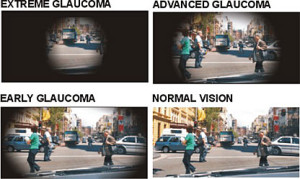Glaucoma is one of the more common causes of vision loss and blindness.
What is most surprising is that over 150,000 Australians have glaucoma and yet do not know!
How could this be?
The answer is that glaucoma is generally a very slow, sinister disease. In most cases there is no pain and no noticeable loss of vision for some years after the disease starts.
This is why optometrists advise everyone to have regular eye examinations.
After you turn 40, you should have your eyes checked at least every two years, as the rate of glaucoma increases after this age.
What is glaucoma?
The major kind of glaucoma is genetic. At its root, glaucoma is a degeneration of the optic nerve at the back of the ey e. This is the nerve that takes the vision impulses from the retina back to the brain for vision processing. Usually, this degeneration is accompanied by a rise in pressure within the eye. However, this increased pressure is generally not felt, unless the pressure rises very high.
e. This is the nerve that takes the vision impulses from the retina back to the brain for vision processing. Usually, this degeneration is accompanied by a rise in pressure within the eye. However, this increased pressure is generally not felt, unless the pressure rises very high.
Eventually, a person with untreated glaucoma will notice disturbance to their vision. The first noticeable change is loss of peripheral vision.
What is the test for glaucoma?
The best way to test for the common kind of glaucoma (open angle) is an OCT scan. This scan will reveal the earliest signs of nerve damage. Other glaucoma tests include a test of the pressure within the eye and a test of the visual fields (peripheral vision).
Can glaucoma be treated?
Yes, but it’s best that it is detected early rather than late. Those with glaucoma need to use special medication (eye-drops) every day for the rest of their lives. This sounds disturbing, but it’s much better than the alternative, which is to slowly lose all your vision.
Make sure you have your eyes examined regularly!
More information on Glaucoma is available at the Glaucoma Australia website.
